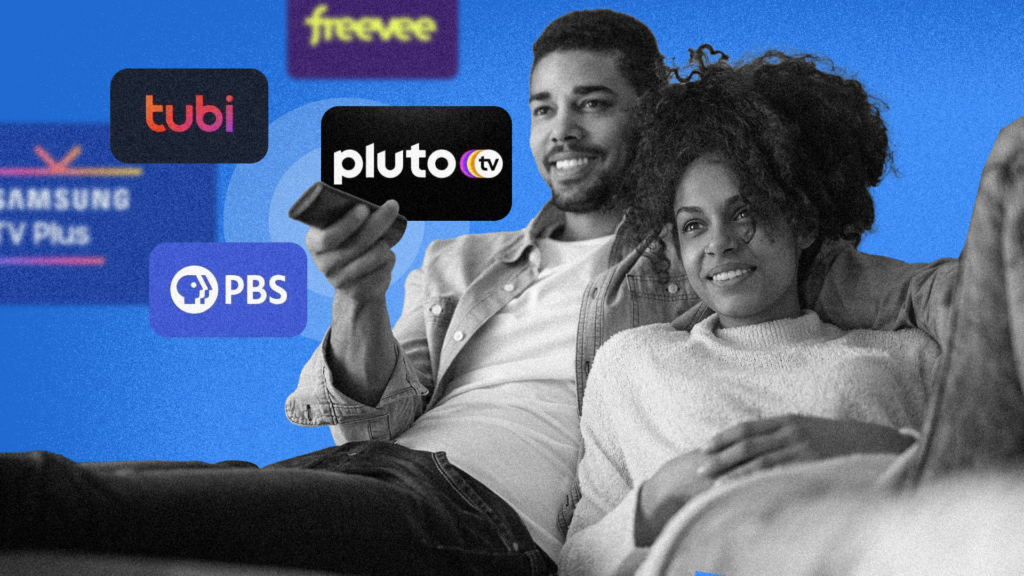Access to high-speed internet has changed the landscape for consumers who want control over when and how they watch their favorite programming. 95% of Americans have access to a 10 Mbps connection, and 80% have access to 1 gigabit. That means a significantly lower dependency on (and tolerance for) over-the-air (OTA), broadcast television.
So where are viewers looking instead?
While subscription-based services like Netflix and Disney+ have struggled recently, the Free Ad-supported Streaming TV (FAST) market is growing exponentially. Recent forecasts estimate that number of U.S. FAST users will grow to nearly 80 million by 2027.
What is FAST?
The FAST model offers free programming/video content in a linear, scheduled format like OTA/cable TV, presented with ad breaks. The benefit to the end user is the ability to watch the ad-supported programming without any cable fees or contracts. It looks like cable, and works like cable — but it’s served up over the user’s internet connection.
Different types of FAST channels
There are three types of FAST channels that are largely dependent on the device you’re accessing them from:
- Device-specific: Devices such as Amazon’s Fire TV, Roku sticks and players, Google devices, and the like have FAST channels that are only accessible by purchasing their products
- TV Manufacturer-specific: Manufacturers of internet-connected TVs — such as LG, Samsung, Vizio, and others — have FAST channels which are only accessible on their devices
- Installable apps: Free to install apps such as Tubi, Pluto TV, Freevee, and Sling Freestream (to name a few) aren’t dependent on the device and allow FAST viewing
How is Free Ad-supported Streaming TV (FAST) growing?
In a given month, two out of three TV content viewers (66%) are consuming content via FAST platforms. Market research from Statista shows that the FAST market’s compound annual growth rate (CAGR) is 9.30%, meaning the market will reach ~$11.83B by 2027.
So what’s contributing to the growth of FAST?
Subscription fatigue: A Global Streaming Study conducted by Simon-Kucher revealed that 42% of subscribers feel they have too many streaming services subscriptions, and that nearly half plan to cancel one or more subscriptions in the next year.
Growth of short-form content: Usage of TikTok has quadrupled since 2021, with 21% of Americans using the app at least weekly, and over a third using the app monthly. This surge in short-form content (and, more importantly, the associated ad revenue) has led companies like YouTube and Facebook to place a larger emphasis on video content users can quickly consume — which means less desire to pay for access to multiple streaming services.
Connected TVs (CTVs) are taking over the world: Manufacturers like LG, Samsung, and Vizio (which offer those TV Manufacturer-specific FAST channels we mentioned earlier) are making huge inroads globally. CTV adoption rates are over 90% in the United States, 87% in India, 70% in Western Europe, and climbing elsewhere. Many manufacturers set their FAST options as the default “startup” content when a TV powers on, capturing viewers interest quickly (and removing the hurdle of “what do I want to watch?” right away).
Monetizing Content with FAST
Streaming, and especially streaming on FAST channels, presents powerful new opportunities for content owners and advertisers alike.
Advertising on FAST and CTV channels is becoming increasingly accessible with the proliferation of “do-it-yourself” services like Google’s DV360, Vibe.co, The Trade Desk, and GumGum. That means advertisers looking to get their message out can quickly go online and, in as little as 5 minutes, have their ads running on your content.
That said, making the most of your content library means maximizing and optimizing on two fronts:
First, you have to expand the reach of your content, which may mean embracing new and emerging opportunities. FAST channels allow you to quickly and easily reach new markets and regions, bypassing traditional models and taking your content directly to the consumer in a way that maximizes your content’s earning potential.
Second, your content itself has to be effectively optimized to maximize your earning potential on these channels. This may mean removing old ad content that was “baked in,” removing ad markers, adding ad markers, or even re-timing the content to make room for additional ad opportunities.
With Time Tailor, our innovative, AI-powered software product, your content can be ready for new markets, channels, and monetization opportunities 90% faster than relying on traditional methods. Combined with the ability to save 60% or greater on editing costs, while generating more space for ad inventory, Time Tailor’s benefits more than pay for themselves and unlock unlimited potential for your library’s earning potential.
Contact us for more information on how Time Tailor can increase revenue, a demo or no-obligation proof of concept, or support for enhancing your content or streaming service’s monetization efforts.
